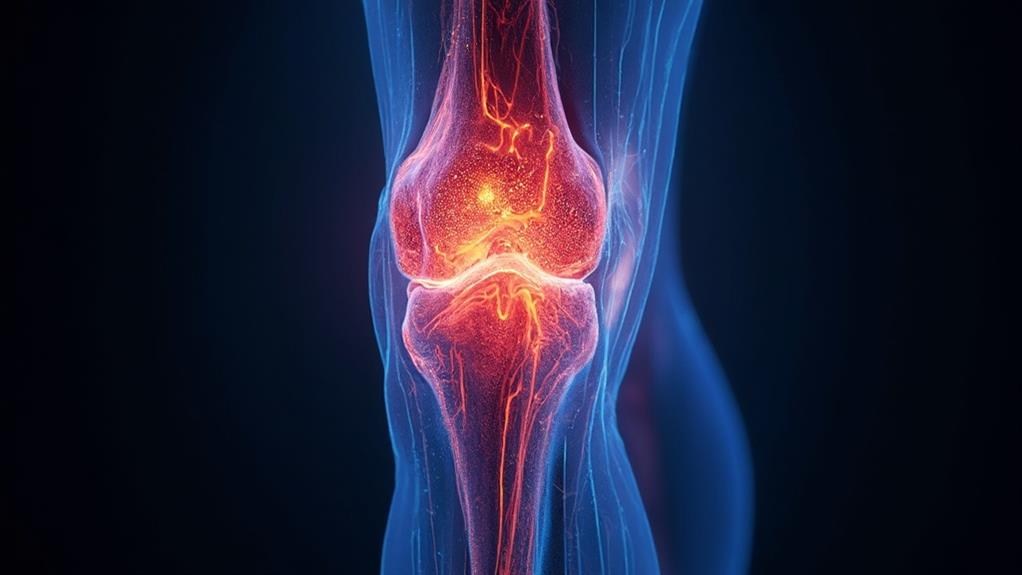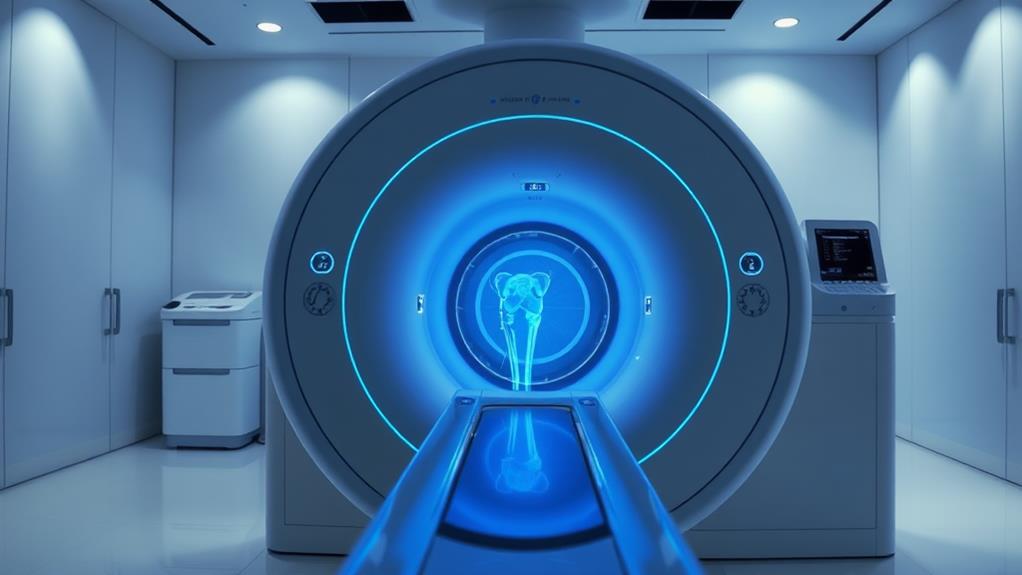The cost of a knee MRI varies substantially based on insurance coverage, geographical location, and the type of facility. Insured patients typically pay copays ranging from $20 to $100, though high-deductible plans can result in out-of-pocket expenses from $500 to $1,000. Uninsured individuals may face charges between $500 and over $3,000. Prices are higher in metropolitan areas like New York, averaging $1,500 to $3,000, while rural areas typically see costs from $500 to $1,000. Standalone imaging centers and urgent care clinics generally offer more competitive rates than hospitals. Understanding these variables can provide a clearer picture of potential MRI expenses.
MRI Highlights
- Patients without insurance face costs ranging from $500 to over $3,000.
- Insured patients typically pay between $20 and $100 in copayments.
- MRIs in metropolitan areas like New York or Los Angeles cost between $1,500 and $3,000.
- Standalone imaging centers offer prices between $500 and $2,500.
- Unexpected fees, including contrast dye and radiologist fees, can add $100 to $500 to the total cost.
Cost Range Specifics

When discussing the cost range of a knee MRI, one must consider the impact of insurance coverage, which can extensively reduce out-of-pocket expenses, depending on the plan.
Additionally, geographical price differences, often influenced by regional healthcare costs, can lead to varying charges for the same procedure.
The type of facility, whether it’s a hospital, outpatient clinic, or a specialized imaging center, also plays an indispensable role in determining the overall cost, with some facilities offering more competitive pricing than others.
Insurance Coverage Impact
Insurance coverage greatly impacts the cost of a knee MRI, with prices varying widely depending on the policy. Those with extensive health insurance might only pay a small copayment, ranging from $20 to $100, particularly if their plan covers diagnostic imaging under standard medical expenses. However, individuals with high-deductible plans might face greater out-of-pocket costs until their deductible is met, potentially leading to expenses between $500 to $1,000. It’s essential to contact one’s insurance provider directly to understand exact coverage details and financial responsibilities.
For those without insurance, the cost can be noticeably higher. Uninsured patients might incur charges ranging from $500 to over $3,000, depending on the facility and any available financial assistance programs. Facilities often provide detailed itemized bills, which can break down the costs into professional fees, facility usage, and imaging interpretation. This clarity helps patients understand where their money is going.
Non-profit organizations and community health initiatives sometimes offer subsidized rates or sliding-scale fees, making MRIs more accessible to those in need. Ultimately, understanding the specifics of one’s insurance coverage and exploring all available financial assistance programs can greatly alleviate the financial burden associated with obtaining a knee MRI.
Geographical Price Differences
Understanding the financial impact of a knee MRI isn’t limited to insurance factors; geographical location also plays a significant role in determining costs. In metropolitan areas, prices for a knee MRI can be substantially higher due to increased overhead and demand. For instance, facilities in cities like New York or Los Angeles might charge upwards of $1,500 to $3,000.
However, in more rural locations, the cost may decrease substantially, with prices averaging between $500 and $1,000.
Regional healthcare economics also influence these price variances. States with a higher general cost of living often reflect this in their medical service pricing. Additionally, competition among providers affects the cost structure. In densely populated areas with numerous healthcare facilities, the competition may drive prices down more than in less populated regions with fewer options.
Understanding these geographical differences is vital for those arranging a knee MRI, particularly for those aiming to minimize out-of-pocket expenses. One could consider traveling to a different location where MRI services are more affordable, thereby achieving financial savings while still receiving quality care. By acknowledging these factors, one can make an informed decision that aligns with both financial constraints and healthcare needs.
Facility Type Variations
While geographical location is a significant factor, the type of facility where an MRI is performed can also greatly impact the cost. Different facilities, such as hospitals, standalone imaging centers, and urgent care clinics, often have varying pricing structures for knee MRIs.
For instance, hospital-based MRI services tend to be more expensive due to higher operational costs and additional fees associated with maintaining extensive medical infrastructure. Here, a knee MRI might cost anywhere from $1,000 to $5,000, depending on the hospital’s location and prestige.
On the other hand, standalone imaging centers generally offer more competitive pricing due to their specialized focus on diagnostic imaging and lower overhead costs. Patients can expect to pay between $500 and $2,500 for a knee MRI at these facilities.
Urgent care clinics, while less common for MRI services, might also provide knee MRIs at a reduced rate, typically ranging from $400 to $1,200.
These cost variations highlight the importance of researching and comparing different facility types when scheduling a knee MRI. By understanding these distinctions, individuals looking to serve others, especially those involved in patient advocacy or healthcare, can make informed decisions that balance quality care with financial considerations.
Benefits

A Knee MRI offers multiple significant benefits, providing detailed imaging that allows physicians to see structures within the knee joint in high resolution, making it an essential non-invasive diagnostic method.
This imaging modality plays a pivotal role in the early detection of potential issues, which subsequently aids in effective treatment planning. Additionally, its ability to capture expansive views without surgical intervention guarantees safer and more precise diagnoses, giving patients and healthcare providers a clear path forward.
Detailed Imaging Explanation
Magnetic Resonance Imaging (MRI) offers detailed imaging of the knee, providing benefits that traditional X-rays and other imaging methods can’t match. The precision of MRI technology lies in its ability to capture extensive images of soft tissues, including muscles, ligaments, cartilage, and other critical structures within the knee. Unlike X-rays, which primarily visualize bones, MRI scans deliver high-resolution images that enable healthcare professionals to detect minute abnormalities, such as small tears or early signs of degeneration, that might otherwise go unnoticed.
For patients experiencing knee pain or injury, this level of detail is indispensable in forming an accurate diagnosis. With an MRI, physicians can pinpoint the exact location and extent of the injury, facilitating tailored treatment plans aimed at promoting recovery and alleviating discomfort. High-resolution imaging also promotes early intervention, often preventing minor issues from escalating into more severe conditions requiring invasive procedures.
Additionally, MRI’s advanced imaging capabilities assist in preoperative planning by providing a broad view of the knee’s internal environment, thereby enhancing surgical precision. As a result, the benefits of MRI extend beyond diagnosis, considerably impacting treatment efficacy and patient outcomes.
Non-Invasive Diagnostics Method
Embracing non-invasive diagnostic methods like MRI scans offers numerous benefits to patients and healthcare providers alike. MRI scans provide a highly detailed view of internal structures without the need for incisions or exposure to ionizing radiation, enhancing patient safety.
This advanced imaging technology allows for an extensive evaluation of soft tissues, bones, and joints, which is vital when appraising knee injuries or conditions. By avoiding invasive procedures, patients experience substantially less discomfort and lower risk of complications, promoting quicker recovery and a more comfortable diagnostic experience.
Healthcare providers also greatly benefit from the use of MRI. The high-resolution images assist in accurate diagnoses, enabling precise treatment planning tailored to each patient’s specific needs. This precision reduces the likelihood of misdiagnoses, which can lead to unnecessary treatments or surgeries, thereby enhancing overall patient care quality.
Additionally, MRI technology supports early detection of potential issues, facilitating timely intervention and better outcomes. Non-invasive methods like MRI scans exemplify modern medical advancements that prioritize patient welfare and diagnostic accuracy. By leveraging such technologies, healthcare professionals can offer more effective, compassionate care, ultimately improving patient satisfaction and health outcomes.
Early Issue Detection
Identifying issues at an early stage markedly enhances treatment success rates, and MRI scans play an essential part in this crucial process. MRI technology offers unparalleled precision in detecting minute knee abnormalities that might escape traditional diagnostic methods. This early detection empowers healthcare providers with the ability to diagnose conditions such as meniscus tears, ligament injuries, and cartilage damage before they progress into more severe and potentially disabling issues.
By catching these problems early, medical professionals can’t only tailor interventions more effectively but also reduce the duration and intensity of rehabilitation needed. For patients serving others, whether they’re athletes, caretakers, or professionals in physically demanding roles, this means quicker recovery times and less time away from their duties. Additionally, when an MRI identifies issues early, it can dramatically reduce the need for invasive procedures by allowing for more conservative management options.
Moreover, early detection through MRI can prevent the exacerbation of knee conditions that might otherwise lead to chronic pain or long-term mobility issues. This is particularly advantageous for those who prioritize being active and reliable in their roles, ensuring they can continue to contribute efficiently to their communities and professional environments.
Treatment Planning Assistance
When planning treatment for knee-related conditions, the benefits of MRI scans can’t be overstated. MRI scans offer unparalleled precision, capturing detailed images of both bone and soft tissues, which facilitates accurate diagnosis and effective treatment planning. For medical professionals tasked with creating targeted interventions, MRI scans are indispensable tools.
Using an MRI, doctors can visualize ligaments, cartilage, and joint fluid in a non-invasive manner, thereby identifying the exact nature and extent of the injury. This high level of detail guarantees that the chosen treatment—be it physical therapy, medication, or surgical intervention—is tailored specifically to the patient’s needs. Accurate imaging translates to better treatment outcomes, ultimately enhancing patient care and well-being.
Moreover, MRIs aid in monitoring the efficacy of ongoing treatments by providing clear before-and-after images, enabling adjustments to the treatment plan as needed. This capability is particularly beneficial in the long-term management of chronic knee conditions, where consistent reevaluation is vital.
For healthcare providers committed to achieving the best for their patients, incorporating MRI scans in the diagnostic and treatment planning phase is essential. The precision and clarity that MRIs provide guarantee that patients receive the most effective treatments, tailored to their specific conditions.
Hidden Fees Breakdown

When undergoing a knee MRI, patients often encounter hidden fees that can markedly increase the overall cost, such as unexpected facility charges, the price of contrast dyes, and additional radiologist fees. Institutions may not always disclose these costs upfront, leaving patients with a surprise on their final bill. Below is a breakdown outlining some of these potential hidden expenses:
| Fee Category | Potential Cost Range ($) |
|---|---|
| Unexpected Facility Charges | 50 – 300 |
| Contrast Dye Costs | 100 – 500 |
| Additional Radiologist Fees | 100 – 400 |
| Consultation Fees | 50 – 200 |
| Administrative Costs | 25 – 100 |
Unexpected Facility Charges
Traversing the cost of a knee MRI can be more complex than it seems, partly due to unexpected facility charges that often emerge after the initial bill. These hidden fees can greatly/substantially/considerably inflate the total cost, catching patients off guard. Facility charges typically encompass the expenses related to the usage of the MRI machine itself, the maintenance of the equipment, and the operational costs of the imaging center or hospital where the MRI is conducted.
Moreover, these charges aren’t always transparently communicated before the procedure, leading to surprise fees that can be both frustrating and financially burdensome. For example, patients might receive separate bills for the radiologist who interprets the MRI results, the use of the MRI suite, and even the administrative handling of the imaging records.
Understanding these potential fees beforehand can help patients make more informed decisions and possibly negotiate costs with their healthcare providers. Advocating for more clarity and upfront information about all potential charges reflects a commitment to serving and caring for others. Being well-informed allows patients to better navigate the financial aspects of their medical care, ensuring they aren’t blindsided by unexpected expenses in an already stressful situation.
Contrast Dye Costs
Patients also need to watch out for the hidden costs associated with contrast dye used in MRI scans. Contrast dye, often a gadolinium-based agent, enhances the images captured during an MRI, making it easier for healthcare professionals to diagnose specific conditions. These agents, however, come with an additional cost, and this cost can vary enormously depending on the provider and location.
Medical facilities that administer contrast dye typically bill separately for this service, adding to the overall expense of the MRI. It’s not uncommon for patients to find this added fee only when they receive their bill, which can range from $100 to $500 or more. This variance is influenced by factors such as the type of dye used and the specific contractual agreements between providers and insurance companies.
To avoid unexpected expenses, patients should proactively inquire about the inclusion of contrast dye in their MRI prior to scheduling the procedure. Understanding whether their insurance will cover this additional cost or if they’ll be responsible for out-of-pocket expenses can help prevent financial surprises. Transparency in billing practices can help patients make more informed decisions about their healthcare, ensuring both their physical and financial well-being are safeguarded.
Additional Radiologist Fees
Besides the primary cost of the MRI and potential expenses for contrast dye, additional fees from radiologists often catch patients off guard. These fees encompass the radiologist’s professional services to analyze the images and provide a detailed report to the referring physician. It’s essential to understand that this fee is separate from the MRI imaging itself.
Typically, radiologist fees vary based on the complexity of the case and the level of expertise required, but they can considerably add to the overall cost of the knee MRI. These fees mightn’t be clear upfront, and often, patients only become aware of them after receiving the invoice.
Patients should also be mindful of the billing practices at different healthcare facilities. Some centers might bundle the radiologist’s fee with the MRI cost, while others bill them separately. To avoid unexpected charges, individuals should ask detailed questions about any additional fees when scheduling their MRI appointment.
Office Equipment FAQ
Is a Knee MRI Covered by My Health Insurance?
Insurance coverage for a knee MRI varies. He should check his specific health plan’s details. Many plans cover MRIs if deemed medically necessary. Providers can help clarify coverage, ensuring patients receive the care they need.
How Long Does a Knee MRI Procedure Take?
A knee MRI typically takes around 30 to 60 minutes, depending on the complexity of the images needed. By ensuring patients are informed and comfortable, healthcare providers can enhance their experience during this essential diagnostic procedure.
What Should I Wear for a Knee MRI?
For a knee MRI, they should wear loose, comfortable clothing without metal. Service-minded professionals will likely provide a gown. They should remove jewelry, watches, and any metal objects to guarantee clear imaging and prevent interference.
Are There Any Risks Associated With a Knee MRI?
She’s wondering if knee MRIs come with any risks. They rarely do, but technicians should always check for metal implants or allergies to contrast agents. Patients with kidney issues should inform their doctors to mitigate potential complications.
Can I Eat or Drink Before a Knee MRI?
They can eat or drink before a knee MRI. However, encouraging them to follow specific instructions provided by their healthcare provider helps guarantee accurate results and supports their comfort during the procedure. Compassionate care makes a difference.
